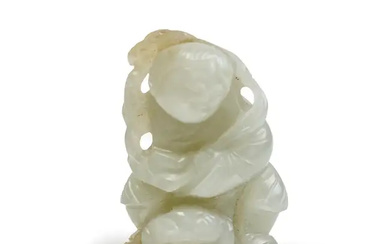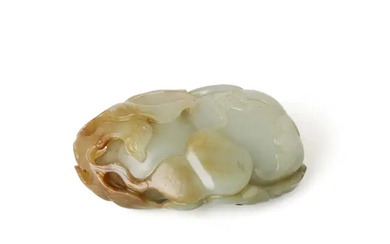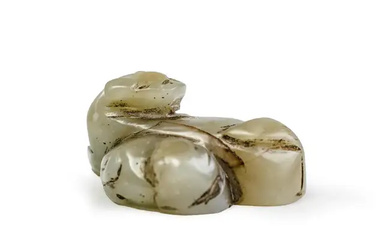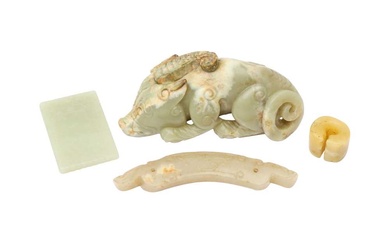A PALE GREEN JADE CARVING OF A TIGER Song/Yuan Dynasty...
A PALE GREEN JADE CARVING OF A TIGER
Song/Yuan Dynasty or later
Crisply carved, the large recumbent feline turned sharply to the right with its paws tucked beneath the squareish head baring sharp fangs, large almond-shaped eyes beneath tubular ears, the ridged spine extending down the back and terminating with a long tail sweeping beneath its right haunch, the stone of pale green tone with frost-white and russet inclusions, box. 10cm (4in) long. (2).
宋/元或以後 青玉雕虎把件
Compare with a related large jade carving of a tiger, Song dynasty or later, in the Victoria and Albert Museum, London, illustrated by M.Wilson, Chinese Jades, London, 2004, no.75. The present piece draws inspiration from jade tigers of the Han dynasty, characterised by their coiled, reclined, or seated posture reflecting the natural shape of the pebble they were carved from. These jade sculptures typically feature squared eyes, minimal incised details, and a flattened base. They may originally have been inspired by Han dynasty bronze mat weights.
Related jade tigers can be found in various notable collections. See a black and yellow jade mythical feline, Southern Song or Yuan dynasty (12th-14th century), illustrated by A.Forsyth and B.McElney, Jades from China, Bath, 1994, no.230. Another related black jade tiger-like beast, Yuan/Ming dynasty, is illustrated in Chinese Jade Animals, Hong Kong, 1996, p.152, no.135.
See a related pale green and brown jade carving of a tiger, Ming dynasty, which was sold at Sotheby's New York, 21 September 2021, lot 52.
Bid on this lot
A PALE GREEN JADE CARVING OF A TIGER
Song/Yuan Dynasty or later
Crisply carved, the large recumbent feline turned sharply to the right with its paws tucked beneath the squareish head baring sharp fangs, large almond-shaped eyes beneath tubular ears, the ridged spine extending down the back and terminating with a long tail sweeping beneath its right haunch, the stone of pale green tone with frost-white and russet inclusions, box. 10cm (4in) long. (2).
宋/元或以後 青玉雕虎把件
Compare with a related large jade carving of a tiger, Song dynasty or later, in the Victoria and Albert Museum, London, illustrated by M.Wilson, Chinese Jades, London, 2004, no.75. The present piece draws inspiration from jade tigers of the Han dynasty, characterised by their coiled, reclined, or seated posture reflecting the natural shape of the pebble they were carved from. These jade sculptures typically feature squared eyes, minimal incised details, and a flattened base. They may originally have been inspired by Han dynasty bronze mat weights.
Related jade tigers can be found in various notable collections. See a black and yellow jade mythical feline, Southern Song or Yuan dynasty (12th-14th century), illustrated by A.Forsyth and B.McElney, Jades from China, Bath, 1994, no.230. Another related black jade tiger-like beast, Yuan/Ming dynasty, is illustrated in Chinese Jade Animals, Hong Kong, 1996, p.152, no.135.
See a related pale green and brown jade carving of a tiger, Ming dynasty, which was sold at Sotheby's New York, 21 September 2021, lot 52.







